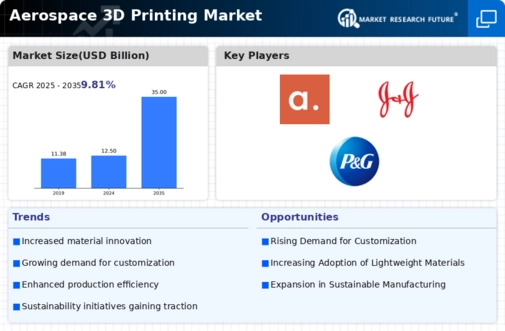Market Growth Projections
The Global Aerospace 3D Printing Market Industry is projected to experience substantial growth, with estimates indicating a market size of 12.5 USD Billion in 2024 and a remarkable increase to 35 USD Billion by 2035. This growth trajectory suggests a compound annual growth rate of 9.81% from 2025 to 2035. Such projections highlight the increasing adoption of additive manufacturing technologies across various aerospace applications, driven by factors such as cost efficiency, customization, and sustainability. As the industry evolves, these figures underscore the potential for significant advancements and innovations in aerospace 3D printing.
Sustainability Initiatives
Sustainability is becoming increasingly important within the Global Aerospace 3D Printing Market Industry. The aerospace sector is under pressure to reduce its environmental footprint, and additive manufacturing presents a viable solution. By utilizing materials more efficiently and reducing waste, 3D printing aligns with global sustainability goals. For example, the production of lightweight components can lead to lower fuel consumption and emissions. As regulatory frameworks and consumer preferences shift towards greener practices, the adoption of 3D printing technologies is likely to accelerate, fostering growth in the market and contributing to its projected expansion.
Technological Advancements
The Global Aerospace 3D Printing Market Industry is witnessing rapid technological advancements that enhance the capabilities of additive manufacturing. Innovations in materials, such as high-performance polymers and metal alloys, are enabling the production of complex geometries that were previously unattainable. For instance, companies are now able to create lightweight components that reduce overall aircraft weight, leading to improved fuel efficiency. This trend is projected to contribute significantly to the market's growth, with the industry expected to reach 12.5 USD Billion in 2024. As these technologies continue to evolve, they are likely to drive further adoption across various aerospace applications.
Cost Reduction in Manufacturing
Cost efficiency remains a pivotal driver in the Global Aerospace 3D Printing Market Industry. The ability to produce parts on-demand reduces inventory costs and minimizes waste, which is particularly beneficial in aerospace where precision is paramount. For example, companies can manufacture spare parts without the need for extensive tooling, thus lowering production costs. This shift towards additive manufacturing is projected to result in a compound annual growth rate of 9.81% from 2025 to 2035. As organizations increasingly recognize the financial benefits of 3D printing, the market is expected to expand, potentially reaching 35 USD Billion by 2035.
Customization and Design Flexibility
Customization is a key advantage of the Global Aerospace 3D Printing Market Industry, allowing manufacturers to tailor components to specific requirements. This flexibility is particularly advantageous in the aerospace sector, where unique designs can enhance performance and safety. For instance, 3D printing enables the production of intricate parts that optimize aerodynamics, contributing to overall aircraft efficiency. As the demand for customized solutions grows, the market is likely to see increased investment in additive manufacturing technologies. This trend suggests that the industry will continue to evolve, further solidifying its position in the aerospace sector.
Regulatory Support and Standards Development
Regulatory support plays a crucial role in shaping the Global Aerospace 3D Printing Market Industry. Governments and industry associations are increasingly establishing standards and guidelines that facilitate the safe integration of 3D printed components into aerospace applications. This support not only enhances confidence among manufacturers but also encourages investment in additive manufacturing technologies. As these regulations evolve, they are likely to streamline certification processes, making it easier for companies to adopt 3D printing. Consequently, this regulatory environment may significantly influence market dynamics, fostering growth and innovation in the aerospace sector.














